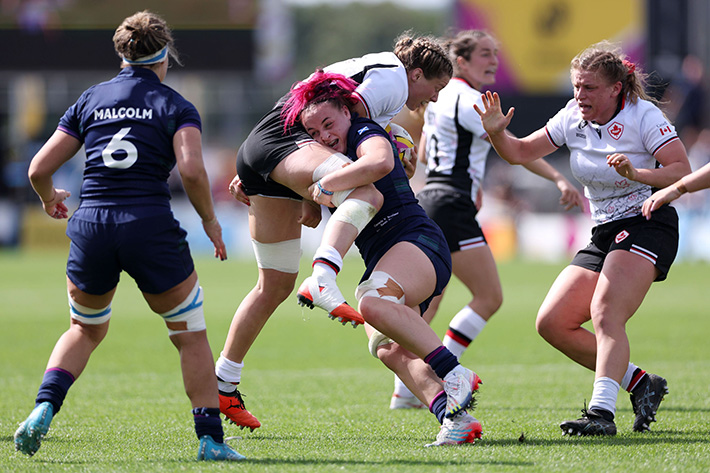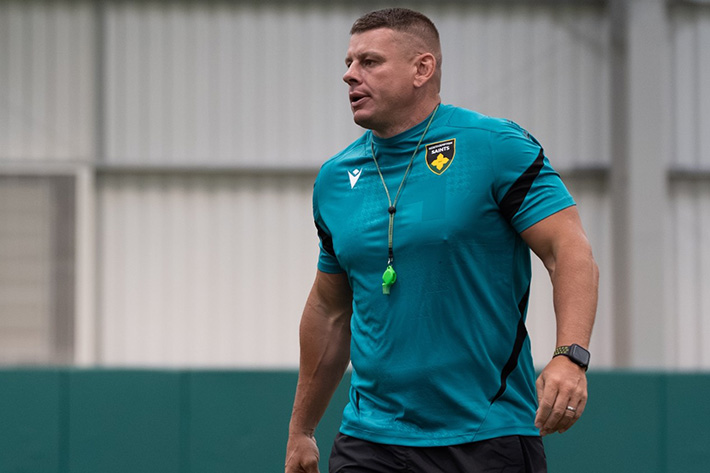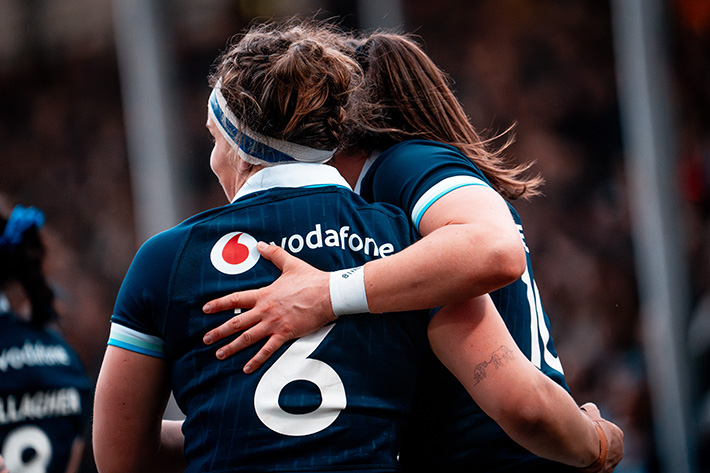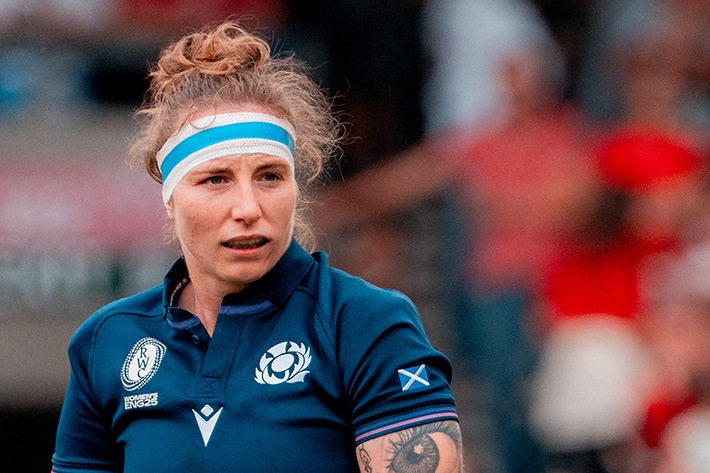Scotland fought hard against one of the title contenders before ultimately coming unstuck, but still had much to be proud of from a committed performance. Here are some talking points
Scotland test Canadian defence
Scotland’s attack has been excellent in the first two rounds of the tournament, but now it was up against one of the strongest defences in the women’s game. Scotland passed this test, playing with pace and detail, and their running lines, both dummy lines and those of the carrier, were consistently excellent, meaning so many of their carries were dominant and the Canadian tackle percentage of 85% was below where they would have wanted, with 29 missed tackles. Scotland’s ruck speed was also excellent, not as fast as Canada’s (who are the fastest international team in the world, men or women’s).
65% of Scotland’s rucks were less than 3 seconds. Looking at the statistics for Canada’s competitive matches this year, in the Pacific 4 and the World Cup pool stages, only Fiji have matched that speed against the Canadians.
Scotland had to be patient, and maybe occasionally needed to be more patient, but the way they kept the ball alive and mixed in fabulously timed passes from the likes of Helen Nelson and Emma Orr to get their dangerous wingers into space, either on the edges or in the middle, made for some beautifully fluid rugby to watch. Francesca McGhie, as we have seen time and again in the tournament, in particular had some impressive runs in the second half, with Rhona Lloyd a couple to match.
In fact, the three tries epitomised these aspects. The first showed Scotland’s ability to keep the ball alive from a penalty quick tap, they worked hard to contract and misalign the defence, picked up the pace at ruck time and kept loads of bodies in motion, fast hands, including a brilliant tip of the fingers pick up and pass on from Rachel McLachlan before Lloyd was over the line in the corner. The second and third both came from brilliant lines from Evie Gallagher and McGhie respectively, and enabled by beautifully weighted passes from Leia Brebner-Holden and Caity Mattinson. All three were real positives to take forward to the quarter-final.
Defence stays mostly solid
If there is one facet the team may be most proud of, it will be there work in defence that for much of the game stopped Canada building much in attack. They weren’t able to slow Canada’s ball down much – Canada had 79% of rucks under 3 seconds, which is frankly ridiculous – but they were able to contain and disrupt. Scotland’s tackle percentage was right back up to where it was in round 1, with 92% completed (only England managed better in round 3), which is even more impressive given the speed at which Canada were playing.
Scotland missed half the number of tackles that Canada did, even though both teams attempted a similar amount. Their line speed was good and their hustle and commitment to disrupting passing channels meant they forced more than a few handling errors in Canada attacks. They will have to keep those standards as high, if they are in anyway to contain the Red Rose juggernaut next up.
Scotland errors undermine efforts to push Canada even closer
So if both attack and defence were overall performing well, how did Scotland end up being defeated by 21 points. Part of it was of course Canada’s class, but an unfortunate amount of it was due to errors that either killed off Scotland’s momentum or gave an opening to the opposition. When playing a top four team, Scotland need everything to go their way – aligned with performing at their highest level – to put themselves in contention for victory. But these errors meant that Scotland spent a lot of time two scores behind, trying to fight their way back into the game.
On penalty advantage in the 16th minute, the ball should have gone from Chloe Rollie to Rhona Lloyd with Asia Hogan-Rochester biting in on Rollie and leaving Lloyd in acres of space. The ball didn’t leave the Canada 22 until Scotland’s first try, but it took a lot more effort to get the score and a much harder angle for the kick.
Perhaps the most frustrating was Lisa Thomson kicking straight to touch from the kick off immediately after the Canada penalty try. Scotland had to survive until half time with just 14 players and this was the worst possible time for such a mistake. Canada scored so quickly and brilliantly off the resulting scrum, with a bit of disorganised defence and it was a bit of a hammer blow to go from having been just 5-7 down to 5-19 down in the blink of an eye.
Scotland started the first few minutes of the second half well, pinning Canada in their own half, and patiently building in attack. But then when the opportunity came to strike, Nelson unfortunately missed touch from a penalty, perhaps a swirl of wind, perhaps over ambition. A few minutes later, some Canadian ill-discipline early second half, gave Scotland a way in, but a risky overthrown lineout led to holding on penalty. At this point, Canada were much more undisciplined than Scotland, but Scotland were slow to capitalise.
Canada, however, always took advantage of Scotland errors. The first 15 minutes of the second half had been excellent from Scotland, but then in the 55th minute they gave away a soft offside penalty – the resulting lineout lead to Canada’s fourth try through Emily Tuttosi, alongside poor defence, snuffing out the chance of a Scotland comeback.
After the disallowed Nelson try (another Scotland mistake) there was another cheap penalty in the next play – side entry at a maul from that first penalty’s line out – and through Alex Tessier’s brilliant kicking to touch, Canada piggy-backed almost to the five-metre line, with little effort. From there Canada had soon powered over the line, 33-12 with 15 minutes to go and pretty much game over.
The possession for Canada’s final try came from a missed Scotland line out, the territory from a loose Scotland pass, and again the powerful Canadian forwards did the rest. It probably made the scoreline tougher on Scotland than their efforts deserved, but it also typified a pattern of the game. It’s not that Canada didn’t make mistakes of their own, often from Scottish pressure, but Scotland did not capitalise in the same way and many of their errors were unforced.
It feels harsh to pick out these negatives in such detail, but it shows that the main difference between the teams on the day was the ability to take clinical advantage of opportunity and to not make errors at crucial times, rather than the overall level of performance.
Kicking battle blows Scotland off course
It was a blustery day at Sandy Park. probably no more evident that when the final conversion from Tessier seemed to stand still at the top of its arc before just popping over the crossbar. Scotland kicked far, far less than they did against Wales or Fiji, and Canada’s kick to pass ratio was even lower.. Although it wasn’t a significant part of the game, it led to a couple of key moments that put Scotland on the back foot and was the other aspect where Canada really outshone Scotland.
There was some good kicking, like Nelson’s first kick to touch and Rollie’s from the second half restart where she really used the wind to gain ground. A Scotland penalty in the 60th minute came from a good, well positioned kick from Thomson, with excellent kick chase. Unfortunately, the line out penalty was the one that resulted in the Nelson disallowed try, but it showed what could have been.
Scotland had the wind against them first half, so it was advantage Canada, but Scotland could have kicked better. An early example was a kick out on the full misjudging the wind, which almost gave Canada a perfect attacking platform, and although that attack broke down, it meant that Nelson’s clearing kick was good but under so much pressure, little territory was gained. From that lineout, the first Canada try came.
Just after the Scotland try, Scotland were willing to get into a kicking battle, but the wind meant that it was always likely to be a net territory loss and so it proved. It didn’t work out badly when Gallagher got a turnover penalty, but Scotland were in the wrong place in the field. The kick from that penalty was not great, with the wind battering it back, and there was a messy line out and eventually Scotland had to settle for clearing it as far as their own 22 line. The next time the ball left Scotland’s 22, Gallagher was in the bin after sustained Canada attack and Scotland were taking a restart after Canada’s second try.
Just after the third Canada try, the team in red put in a clever kick in behind, but Scotland were now less sure about kicking, Rollie and Thomson miscommunicated and it ended up with a knock on in the Scotland 22. At this point it felt like the wheels were coming off.
With the change of ends, there was hope that this could give Scotland an advantage, but apart from a couple of the examples noted above, Scotland never really kicked much after this or took advantage of having the wind behind them. Perhaps it was just recognition of how well Tessier was playing even into the wind, but it felt a missed opportunity. We have seen Scotland struggle with their kicking game against top teams before, especially in unhelpful weather, and it is something they will be looking to improve on for the quarter final.

Chart-topping Evie
Despite her yellow card, Gallagher continues to be absurdly good. She was sorely missed when off the pitch. For the 10 minutes she was off, Scotland were 12-0 down. But the margin was only 9 for the 70 minutes she was on.
Her work rate is incredible, and she tops the stats charts for the groups stages with the most tackles (59) and ruck arrivals (106, 20 more than any other player), sitting 4th for attacking ruck arrivals and top, and a long way clear, for defensive ruck arrivals. She is joint 5th for turnovers won and she has also made 30 carries for 104 metres and beaten 8 defenders, all more than any other Scotland forward. The line she cut for the try in this game was superb (aided by perfect timing on the pass by Brebner-Holden). And she presumably tops the charts for tries scored while pulling up shorts.
Francesca McGhie also deserves a shout out when it comes to being at or near the top of the charts. Her 6 tries so far equal Lucy Millard’s record for world cup tries for Scotland and she is joint top try scorer for the tournament so far. She is second for metres gained (behind Black Fern wonder kid Braxton Sorensen-McGee – is there something about that surname?), third for defenders beaten and second for line breaks.
Let’s hope this pair, along with the continuously classy Emma Orr, can continue to shine in the knockout stages.









2 responses
Let’s be honest anyone following Scotland would have bitten your arm off for qualifying out of the group. We could have easily gone home without a win like Wales . Whatever way you look at this tournament it’s been a major success particularly with the contract and coaching issues off field.
Orr, Gallagher , McGhie would get into almost anyone’s team of the tournament. I can’t think of a single player who has been a disappointment. Team spirit has been fantastic which says a lot for the leaders on and off the field.
Kicking has been a bit of an issue but for example in the game against Canada conditions were terrible.
The set piece has been fine mostly. Skeldon’s injury has disrupted the line out a bit . The scrim though has held its own even against Canada.
I give us 10% chance of beating England but playing them is a success in itself.
Time to invest broaden even more the pool, improve the off field team and get Mr Paterson their to help with our kicking. Wonderful tournament where every player played their part. I’m an old man but if I was a young girl looking for a sport these players would have inspired me.
Unlike the men’s team, these ladies got out of the group. Well done. They looked like they enjoyed themselves.